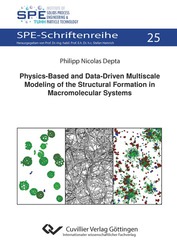| Areas | |
|---|---|
| Serie de libros (96) |
1377
|
| Nachhaltigkeit |
3
|
| Gesundheitswesen |
1
|
| Letra |
2362
|
| Ciencias Naturales |
5405
|
| Matemática | 229 |
| Informática | 318 |
| Física | 980 |
| Química | 1363 |
| Geociencias | 131 |
| Medicina humana | 243 |
| Estomatología | 10 |
| Veterinaria | 108 |
| Farmacia | 147 |
| Biología | 835 |
| Bioquímica, biología molecular, tecnología genética | 121 |
| Biofísica | 25 |
| Nutrición | 45 |
| Agricultura | 1004 |
| Silvicultura | 201 |
| Horticultura | 20 |
| Ecología y conservación de la tierra | 148 |
| Ciencias Ingeniería |
1789
|
| General |
97
|
|
Leitlinien Unfallchirurgie
5. Auflage bestellen |
|
Erweiterte Suche
Physics-Based and Data-Driven Multiscale Modeling of the Structural Formation in Macromolecular Systems (Volumen 25) (Tienda española)
Philipp Nicolas Depta (Autor)Previo
Lectura de prueba, PDF (130 KB)
Indice, PDF (51 KB)
In order to improve knowledge on macromolecular structural formation and self-assembly, this work proposes a physics-based and data-driven multiscale modeling framework capable of describing structural formation on micro-meter and milli-second scales near molecular-level precision. The framework abstracts macromolecules as anisotropic unit objects and models the interactions and environment using data-driven approaches. The models are parameterized in a bottom-up fashion and validated top-down by comparison with literature and collaborator data for self-assembly of three model system: alginate gelation, hepatitis B virus capsids, and the pyruvate dehydrogenase complex.
| ISBN-13 (Impresion) | 9783736979727 |
| ISBN-13 (E-Book) | 9783736969728 |
| Formato | B5 |
| Idioma | Inglés |
| Numero de paginas | 296 |
| Laminacion de la cubierta | mate |
| Edicion | 1. |
| Serie | SPE-Schriftenreihe |
| Volumen | 25 |
| Lugar de publicacion | Göttingen |
| Lugar de la disertacion | TU Hamburg |
| Fecha de publicacion | 27.02.2024 |
| Clasificacion simple | Tesis doctoral |
| Area |
Bioquímica, biología molecular, tecnología genética
Biofísica Ingeniería mecánica y de proceso |
| Palabras claves | multiscale modeling, molecular modeling, Molecular Discrete Element Method, MDEM, Discrete Element Method, DEM, coarse-graining, Molecular Dynamics, MD, Langevin dynamics, machine learning, ML, supervised learning, Kriging, macromolecular self-assembly, structural formation simulation, anisotropic macromolecules, assembly pathways, assembly kinetics, molecular collisions, 6D intermolecular interaction potentials, specialized force-fields, molecular binding, bonded interaction, hepatitis B core antigen, HBcAg, capsid formation, virus-like particles, VLP, pyruvate dehydrogenase complex, PDC, alginate, alginic acid, biopolymer, gelation, gel, aerogel, porous nanomaterial, anisotropic diffusion, ion binding model, calcium, proteins, enzymes, multi-enzymatic biocatalysis, metabolic channeling, high performance computing, HLRS, GPU implementation, MUSEN |








